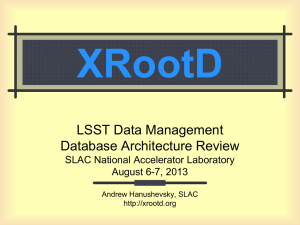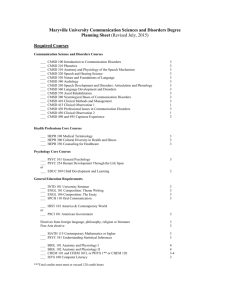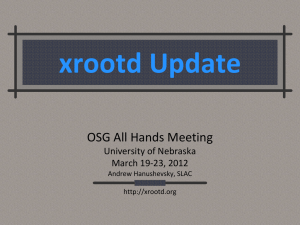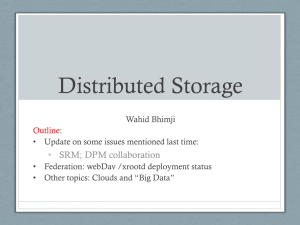CMS evolution on data access: xrootd remote access and
advertisement
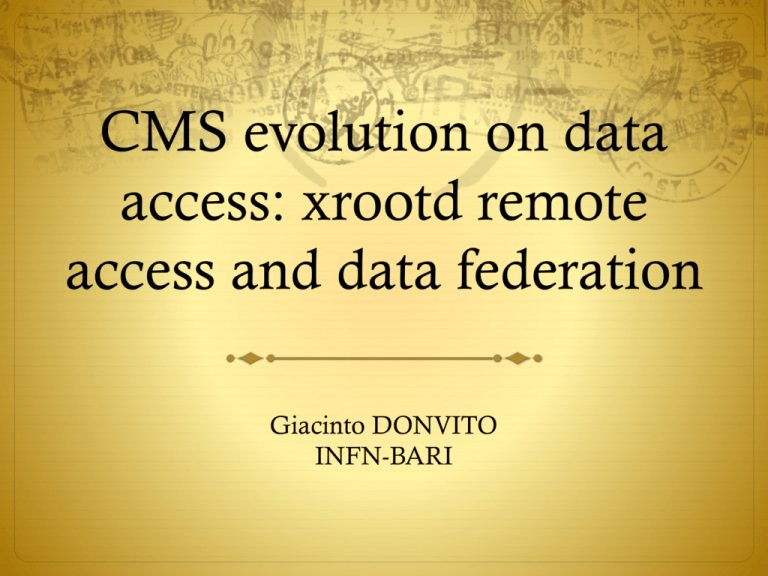
CMS evolution on data
access: xrootd remote
access and data federation
Giacinto DONVITO
INFN-BARI
Outlook
CMS computing model: first assumptions and results
Technology trends and impact on HEP Computing
models
Xrootd concepts and features
CMS framework enhancements
Xrootd Redirector use cases and basic ideas
Xrootd Redirectors actual deployment
Xrootd first test and monitoring
Outlook
CMS computing model: first assumptions and results
Technology trends and impact on HEP Computing
models
Xrootd concepts and features
CMS framework enhancements
Xrootd Redirector use cases and basic ideas
Xrootd Redirectors actual deployment
Xrootd first test and monitoring
CMS computing model: first assumptions
The Computing Models of the LHC experiments were designed using
Monarc (Models of Networked Analysis at Regional Centers for LHC
Experiments) Model assumption:
Resource are located in distributed centers with a hierarchical structure
Tier 0 Master computing center, full resource set (disks and tapes)
Tier 1 National Centre, resource subset (disks and tapes)
Tier 2 Major Centre (only disks)
Tier 3 University Department
The network will be bottleneck
We will need a hierarchical mass storage because we cannot afford sufficient local disk
space
The file catalogue will not scale
We will overload the source site if we ask for transfers to a large number of sites
We need to run job “close” to the data to achieve efficient CPU utilization
We need a a priori structured and predictable data utilization
CMS computing
model:
first
assumptions
Tiers archit ect ure
(it applies to all LHC exps, though)
~PBytes/sec
Online System
~100 MBytes/sec
Offline Processor Farm
~20 TIPS
There is a “bunch crossing” every 25 nsecs.
There are 100 “triggers” per second
Each triggered event is ~1 MByte in size
~100 MBytes/sec
~622 Mbits/sec
or Air Freight (deprecated)
Tier 1
France Regional
Centre
1 TIPS is approximately 25,000
SpecInt95 equivalents
Tier 0
Germany Regional
Centre
CERN Computer Centre
Italy Regional
Centre
FermiLab ~4 TIPS
~622 Mbits/sec
Tier 2
~622 Mbits/sec
InstituteInstitute Institute
~0.25TIPS
Physics data cache
Institute
~1 MBytes/sec
Caltech
~1 TIPS
Tier2 Centre
Tier2 Centre
Tier2 Centre
Tier2 Centre
~1 TIPS ~1 TIPS ~1 TIPS ~1 TIPS
Physicists work on analysis “channels”.
Each institute will have ~10 physicists working on one or more
channels; data for these channels should be cached by the
institute server
Tier 4
Physicist workstations
[ Image courtesy of Harvey Newman, Caltech ]
CMS computing model: first assumptions
Ot her rout es: T&! T! $$$ example: CM S
40 MB/s
Take CM S dat a Cow as example
(RAW, RECO, AOD)
CM S T&² T! t ransfers likely t o be burst y and driven by analysis
demands
Tier-0
D&" 4&" " M B4s for worst 4best connect ed T! +s )! " " 5*
CM S T! ² T&t ransfers almost ent irely fairly cont inuous
simulat ion t ransfers
AOD
Tier-1s
D &" M B4s )NOTE: aggregat e input rat e int o T&+s comparable t o rat e
from T" ! *
AOD
48 MB/s
(MC)
Tier-1
2.5 MSI2K
1.0 PB disk
2.4 PB tape
~10 Gbps WAN
Tier-2s
240 MB/s
tape
(skimmed AOD,
Some RAW+RECO)
280 MB/s
~800 MB/s
(AOD skimming,
data reprocessing)
(RAW, RECO, AOD)
225 MB/s
(RAW)
WNs
280 MB/s
Tier-0
(RAW, RECO, AOD)
4.6 M-SI2K
0.4 PB disk
4.9 PB tape
5 Gbps WAN
225 MB/s
(RAW)
Tier-1s
60 MB/s
(skimmed AOD,
Some RAW+RECO)
Tier-1
0.9 M-SI2K
0.2 PB disk
1 Gbps WAN
12 MB/s
(MC)
Up to 1 GB/s
(AOD analysis,
calibration)
WNs
NB: averaged sustained throughputs.
Courtesy: J.Hernandez (CMS)
CCR ! " " # $ Gran Sasso%&" June " #
Tier-2
D' Bonacorsi
WNs
!,
CMS computing model: first results
Data transfers among sites is much more reliable than
expected
WAN network performances are growing fast and the network
infrastructure is reliable
Retrieving files from a remote sites could be easier than
retrieving it from a local hierarchical mass storage system
It looks like we need a clearer partition between disk and tape
Using tape only like an archive
Geographically distributed Job submission and matchmaking
are working well
The tool developed to help the final users are easy and make the
usage of the grid transparent to the user
CMS computing model: first results
From CERN
From T1s
It is “easy” to get out of a single
T0/T1 up to 300-400MB/s
sustained of WAN transfer to all
others CMS sites
CMS computing model: first results
A very small
number of datasets
are used very
heavily
Outlook
CMS computing model: first assumptions and results
Technology trends and impact on HEP Computing
models
Xrootd concepts and features
CMS framework enhancements
Xrootd Redirector use cases and basic ideas
Xrootd Redirectors actual deployment
Xrootd first test and monitoring
Technology trends and impact on
HEP Computing models
Technology trends and impact on
HEP Computing models
The WAN available bandwidth is comparable with the
backbone available at LAN level
Network flows are already larger than foreseen at this point in
the LHC program, even with lower luminosity
Some T2’s are very large
All US ATLAS and US CMS T2’s have 10G capability.
Some T1-T2 flows are quite large (several to 10Gbps)
T2-T2 data flows are also starting to become significant.
The concept of transferring file regionally is substantially
broken!
Technology trends and impact on
HEP Computing models
The vision progressively moves away from all hierarchical
models to peer-peer
True for both CMS and ATLAS
For reasons of reduced latency, increased working efficiency
The challenge in the next future will be the available IOPS on
storage systems
It is clear we need to optimize the IO at the application level as
the disk will not increase the performance too much in the future
The hierarchical mass storage system could not cope with
dynamic data stage-in request
The cost per TB of the disk allow us to build huge disk-only
facilities
Outlook
CMS computing model: first assumptions and results
Technology trends and impact on HEP Computing
models
Xrootd concepts and features
CMS framework enhancements
Xrootd Redirector use cases and basic ideas
Xrootd Redirectors actual deployment
Xrootd first test and monitoring
Xrootd concepts and features
What Is xrootd ?
A file access and data transfer protocol
Defines POSIX-style byte-level random access for
Arbitrary data organized as files of any type
Identified by a hierarchical directory-like name
A reference software implementation
Embodied as the xrootd and cmsd daemons
xrootd daemon provides access to data
cmsd daemon clusters xrootd daemons together
Xrootd concepts and features
What Isn’t xrootd ?
It is not a POSIX file system
There is a FUSE implementation called xrootdFS
An xrootd client simulating a mountable file system
It does not provide full POSIX file system semantics
It is not an Storage Resource Manager (SRM)
Provides SRM functionality via BeStMan
It is not aware of any file internals (e.g., root files)
But is distributed with root and proof frameworks
As it provides unique & efficient file access primitives
Xrootd concepts and features
Primary xrootd Access Modes
The root framework
Used by most HEP and many Astro experiments (MacOS, Unix and Windows)
POSIX preload library
Any POSIX compliant application (Unix only, no recompilation needed)
File system in User SpacE
A mounted xrootd data access system via FUSE (Linux and MacOS only)
SRM, globus-url-copy, gridFTP, etc
General grid access (Unix only)
xrdcp
The parallel stream, multi-source copy command
(MacOS, Unix and Windows)
xrd
The command line interface for meta-data operations (MacOS, Unix and
Windows)
Xrootd concepts and features
What Makes xrootd Unusual?
A comprehensive plug-in architecture
Security, storage back-ends (e.g., tape), proxies, etc
Clusters widely disparate file systems
Practically any existing file system
Distributed (shared-everything) to JBODS (shared-nothing)
Unified view at local, regional, and global levels
Very low support requirements
Hardware and human administration
Xrootd concepts and features
Authentication
Protocol Driver
(gsi, krb5, etc)
(XRD)
Protocol (1 of n)
(xroot, proof, etc)
lfn2pfn
prefix encoding
Authorization
(dbms, voms, etc)
Logical File System
Let’s take a closer look (ofs, sfs, alice, etc)
at xrootd-style clustering
Clustering
(cmsd)
Physical Storage System
(ufs, hdfs, hpss, etc)
Replaceable plug-ins to
accommodate any environment
Xrootd concepts and features
A Simple xrootd Cluster
Client
1:
4: open(“/my/file”)
Try open() at A
Manager
xroot cmsd
d
(a.k.a. Redirector)
2: Who has “/my/file”?
xroot cmsd
d
A /my/file
xroot cmsd
d
B
xroot cmsd
d
C /my/file
Data Servers
Xrootd concepts and features
Exploiting Stackability
Client
1:5:open(“/my/file”)
Try open() at ANL
Meta-Manager
xroot cmsd
d
(a.k.a. Global Redirector)
6:7:
open(“/my/file”)
Try open() at A
8: open(“/my/file”)
Data is uniformly available
2: Who has “/my/file”?
By federating three distinct sites
xroot cmsd
d
Manager
(a.k.a. Local Redirector)
S
e
xroot cmsd
r
d
v
e
C
B /my/file
xroot cmsd
xroot cmsd
r
s
d
d
A /my/file
C
B /my/file
ANL 3: Who has “/my/file”?
xroot cmsd
d
Manager
(a.k.a. Local Redirector)
xroot cmsd
d
C /my/file
xroot cmsd
xroot cmsd
d
d
A
B
SLAC
S
e
r
v
e
r
s
3: Who has “/my/file”?
xroot cmsd
d
Manager
(a.k.a. Local Redirector)
xroot cmsd
d
C /my/file
xroot cmsd
xroot cmsd
d
d
A /my/file
B
UTA
S
e
r
v
e
r
s
3: Who has “/my/file”?
An exponentially parallel search!
(i.e. O(2n))
Federated
Distributed
Clusters
Distributed
Clusters
Xrootd concepts and features
Federated Distributed Clusters
Unites multiple site-specific data repositories
Each site enforces its own access rules
Usable even in the presence of firewalls
Scalability increases as more sites join
Essentially a real-time bit-torrent social model
Federations are fluid and changeable in real time
Provide multiple data sources to achieve high transfer rates
Increased opportunities for data analysis
Based on what is actually available
Xrootd concepts and features
Copy Data Access Architecture
The built-in File Residency Manager drives
Copy On Fault
Demand driven (fetch to restore missing file)
Copy On Request
Pre-driven (fetch files to be used for analysis)
open(“/my/file”)
Client
xrdcp –x xroot://mm.org//my/file /my
xroot cmsd
d
xroot cmsd
d
Manager
(a.k.a. Local Redirector)
S
e
xroot cmsd
r
d
v
e
C /my/file
xroot cmsd
xroot cmsd
r
s
d
d
A /my/file
B /my/file
ANL
xrdcp copies data
xroot cmsd
d
Manager
(a.k.a. Local Redirector)
xroot cmsd
d
C /my/file
xroot cmsd
xroot cmsd
d
d
A /my/file
B
SLAC
using two sources
S
e
r
v
e
r
s
xroot cmsd
d
Meta-Manager
(a.k.a. Global Redirector)
Manager
(a.k.a. Local Redirector)
xroot cmsd
d
C /my/file
xroot cmsd
xroot cmsd
d
d
A /my/file
B
UTA
S
e
r
v
e
r
s
Xrootd concepts and features
Direct Data Access Architecture
Use servers as if all of them were local
Normal and easiest way of doing this
Latency may be an issue (depends on algorithms & CPU-I/O ratio)
Requires Cost-Benefit analysis to see if acceptable
open(“/my/file”)
Client
xroot cmsd
d
xroot cmsd
d
Manager
(a.k.a. Local Redirector)
S
e
xroot cmsd
r
d
v
e
C /my/file
xroot cmsd
xroot cmsd
r
s
d
d
A /my/file
B /my/file
ANL
xroot cmsd
d
Manager
(a.k.a. Local Redirector)
xroot cmsd
d
C /my/file
xroot cmsd
xroot cmsd
d
d
A
B
SLAC
S
e
r
v
e
r
s
xroot cmsd
d
Meta-Manager
(a.k.a. Global Redirector)
Manager
(a.k.a. Local Redirector)
xroot cmsd
d
C /my/file
xroot cmsd
xroot cmsd
d
d
A /my/file
B
UTA
S
e
r
v
e
r
s
Xrootd concepts and features
Cached Data Access Architecture
Front servers with a caching proxy server
Client access proxy server for all data
Server can be central or local to client (i.e. laptop)
Data comes from proxy’s cache or other servers
open(“/my/file”)
Client
xroot
d
xroot cmsd
d
Manager
(a.k.a. Local Redirector)
xroot cmsd
d
C /my/file
xroot cmsd
xroot cmsd
d
d
A
B
ANL
S
e
r
v
e
r
s
xroot cmsd
d
xroot cmsd
d
Manager
(a.k.a. Local Redirector)
xroot cmsd
d
C /my/file
xroot cmsd
xroot cmsd
d
d
A /my/file
B
SLAC
S
e
r
v
e
r
s
xroot cmsd
d
Meta-Manager
(a.k.a. Global Redirector)
Manager
(a.k.a. Local Redirector)
xroot cmsd
d
C /my/file
xroot cmsd
xroot cmsd
d
d
A
B
UTA
S
e
r
v
e
r
s
Outlook
CMS computing model: first assumptions and results
Technology trends and impact on HEP Computing
models
Xrootd concepts and features
CMS framework enhancements
Xrootd Redirector use cases and basic ideas
Xrootd Redirectors actual deployment
Xrootd first test and monitoring
CMS framework enhancements
The CMSSW 4_X contains ROOT 5.27/06b, which has
significant I/O improvements over 3_x
CMSSW 4_x also contains modest I/O improvements on top
of out-of-the-box ROOT I/O
New ROOT added:
Auto-flushing: All buffers are flushed to disk periodically,
guaranteeing some level of locality.
Buffer-resizing: Buffers are resized so approximately the same
number of events are in each buffer.
Read coalescing: “Nearby” reads (but non-consecutive) are
combined into one.
CMS framework enhancements
Incremental improvements through 3_x and 4_x: Only one
event tree, improved event read ordering,TTreeCache became
functional, caching non-event trees.
Improved startup: While TTreeCache is being trained, we
now read all baskets for the first 10 events at once. So, startup
is typically one large read instead of many small ones.
Improved startup
latencies (simplified)
CMSSW 3_X
Branch
Event
Event
Training
{
CMSSW 4_2
Branch
7 read calls
2 read calls
21 squares read 27 squares read
= individual read
= vectored read
We read all branches
for the first 20 events;
compared to the entire
file size, the bandwidth
cost is minimal. On
high latency links, this
can cause a 5 minute
reduction in time to
read the first 20 events.
CMS framework enhancements
Upcoming Enhancements
“Real” Asynchronous prefetch (using threads and doublebuffering). Brian’s opinion: the current patch set is
problematic and not usable by CMS. At least a year out.
Additional reduction in un-streaming time. Multi-threaded
un-streaming.
ROOT implementation of things in CMSSW: multiple
TTreeCaches per file. Improved startup latencies.
Outlook
CMS computing model: first assumptions and results
Technology trends and impact on HEP Computing
models
Xrootd concepts and features
CMS framework enhancements
Xrootd Redirector use cases and basic ideas
Xrootd Redirectors actual deployment
Xrootd first test and monitoring
Xrootd Redirector use cases and basic ideas
The goal of this activity is to decrease the effort required for
the end- user to access CMS data.
We have built a global prototype, based on Xrootd, which
allows a user to open (almost) any file in CMS, regardless of
their location or the file’s source.
Goals:
Reliability: Seamless failover, even between sites.
Transparency: Open the same filename regardless of source
site.
Usability: Must be native to ROOT.
Global: Cover as many CMS files as possible.
Xrootd Redirector use cases and basic ideas
The target of this project:
End-users: event viewers, running on a few CMS files, sharing
files with a group.
T3s: Running medium-scale ntuple analysis
None of these users are well-represented by CMS tools right
now.
So, a prototype is better than nothing…
Xrootd Redirector use cases and basic ideas
Xrootd Prototype
Have a global redirector users can contact for all
files.
Can use any ROOT-based app to access the prototype
infrastructure! Each file only has one possible URL
Each participating site deploys at least 1 xrootd
server that acts like a proxy/door to the external
world.
Xrootd Redirector use cases and basic ideas
Illustration
Xrootd Redirector use cases and basic ideas
1. Attempt login
4. Login successful!
Remote User
5. Open /store/foor
Xrootd
4. Open successful!
2. Request mapping 3. Result: 6. Can brian open
for DN / VOMS
/store/foo?
User "brian"
7. Permit
LCMAPS
(Site
mapping
policy)
Authfile
The
authentication
is always
delegated to
the site
hosting the file
Xrootd Redirector use cases and basic ideas
Xrootd Redirector use cases and basic ideas
Xrootd Redirector use cases and basic ideas
Outlook
CMS computing model: first assumptions and results
Technology trends and impact on HEP Computing
models
Xrootd concepts and features
CMS framework enhancements
Xrootd Redirector use cases and basic ideas
Xrootd Redirectors actual deployment
Xrootd first test and monitoring
Xrootd Redirectors actual deployment
Site Integration
We have yet to run into a storage system that cannot be
integrated with Xrootd. Techniques:
POSIX:Works out-of-the-box. Example: Lustre.
C API: Requires a new XrdOss plugin. Example: HDFS,
dcap, REDDNet (?)
Native implementation: Latest dCache has built-in Xrootd
support; combine with xrootd.org cmsd to join federation.
Direct access: Let xrootd read the other system’s files
directly from disk (dCache @ FNAL)
Xroot over HDFS
Local HDFS
installation
Xrootd
redirector
Native
Xrootd
local
door
In this case: we need a native xrootd door reading file using
hdfs standard C library
This is quite similar to the installation of a gridftp door
Xroot over xroot
Local dCache
installation
Dcache
xrootd
door
Xrootd
EU
redirector
Native
Xrootd
local
door
In this case: we need a native xrootd door reading file using
xroot library
This machine is configurated in “proxy-mode”
This needs that the dCache instance already provide a dCache
xrootd endpoint
Xroot over posix
Local
GPFS/Lustre
installation
Xrootd
EU
redirector
Native
Xrootd
local
door
In this case: we need one or more native xrootd doors that are
clients of the local parallel file-system (GPFS/Lustre)
Xrootd Redirectors actual deployment
CMSSW Performance
Note the use cases all involve wide-area access to CMS
data, whether interactively or through the batch system.
WAN performance for the software is key to this project’s
success.
Current monitoring shows 99% of the bytes CMS jobs
requests are via vectored reads - many jobs have about 300
reads per file total. That’s at least 30s of I/ O that a locally
running job wouldn’t have.
We plan to invest our time in I/O to make sure these
numbers improve, or at least don’t regress.
Xrootd Redirectors actual deployment
Xrootd deployment
US Xrootd Redirector:
@Nebraska
Collecting data from US Sites:
Nebraska, Purdue, Caltech, UCSD, FNAL
EU Xrootd Redirector:
@INFN_Bari
Collecting data from EU Sites:
INFN-Bari, INFN-Pisa, DESY, Imperial College (UK)
Xrootd Redirectors actual deployment
Xrootd deployment
Xrootd provides per-file and per-connection monitoring.
I.e., a UDP packet per login, open, close, disconnect, and
summarizing every 5s of activity.
This is forwarded to a central server, where it is summarized
and forwarded to to several consumers.
Also provides a perserver summary
(connections, files
open) that is fed
directly to MonaLisa.
Xrootd Redirectors actual deployment
Xrootd distributed performance
Using CMSSW 4_1_3 and a I/O bound analysis
Job are running on T2_IT_LNL and data are hosted in
T2_IT_Bari
ping time: 12ms
CPU Efficiency drop from 68% to 50%
~30% of performance drop
This is about to be one of the worst case
Xrootd Redirectors actual deployment
Xrootd distributed performance
Conclusion
Xrootd redirector infrastructure is fulfilling few use cases that
are not covered by official CMS tools
It is already been used:
from both final users
Debugging code, visualization etc.
and computing center
That do not have enough man power to fully support CMS
locally
Tuning CMSSW is very important in order to provide good
performance when accessing data remotely

